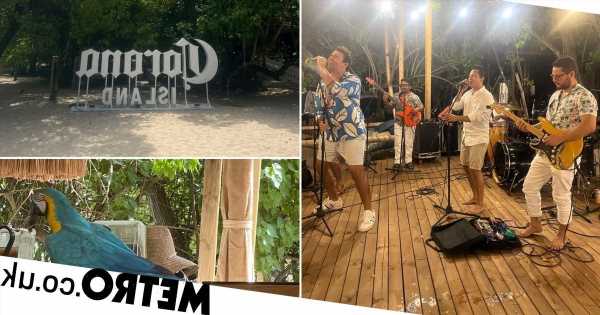To view this video please enable JavaScript, and consider upgrading to a webbrowser thatsupports HTML5video
When you hear the word Corona, you certainly don’t put island next to it. But it’s year three of the pandemic, and the beer brand is tired of all the negative connotations of the word.
So to make you forget that it shares a name with a pandemic-starting illness, the brand has gone and built a whole paradisiacal island.
When I was invited to visit Corona Island, located off the coast of Colombia, meaning glorious Caribbean sun and waters, I could hardly wait. And, dear reader, it did not disappoint.
Sunshine, turquoise waters that rival the Maldives, jacuzzis, a beach view, exotic animals, fresh fruits, local dishes, award-winning paellas. This might just be the best press trip a journalist has been on.
You may be thinking Corona Island is a gimmick for maximum exposure, but the Mexican beer retailer has a current value of $5.8 billion and its held on to its title as the world’s best beer brand, so they’re probably doing okay for publicity.
Instead of a money-grabbing opportunity (this island hosts 20 guests at a time), the creators have aimed for a tropical, sustainable destination for eco-tourism. Corona Beer has worked with the nonprofit Oceanic Global to achieve its sustainability goals, and been awarded the Ocean Global Blue seal for banning single-use plastic.
The island also uses other sustainable elements including solar panels over on-site housing, powering up to 70% of the island’s energy needs, bungalows constructed from locally sourced wood, and water refill stations in place of disposable bottles.
For the food, created by Chilean chef (and MasterChef judge and presenter) Christopher Carpentier, locally sourced ingredients are used for menu items, desserts are made from leftover food scraps, and a herb garden on the island is used for guest meals.
We gorged on paellas, traditionally Colombian dishes such as Pescado Frito (fried red snapper), arepas, yuca fritters, cheesy pandebono bread, steak, tuna, and delicious fresh vegetables.
Though you might associate a lime-dunked bottle of Corona with summer and parties, Corona Island isn’t trying to be the next Ibiza or Magaluf.
This tranquil paradise is for those who want to enjoy an eco beachy trip, feeling connected to the environment while catching a tan in the process.
During our trip, we were taken on a mangrove tour to learn more about how they protect coastal lands. A mangrove is a group of trees that provides a natural infrastructure to land as they prevent erosion and absorb the impact of storms during extreme weather such as hurricanes.
We were even able to plant a tree or two, which was a meaningful experience that made us feel a part of nature.
We were also able to learn more about the coral reefs during a somewhat hangover-heavy snorkeling session, lamenting the bleaching process that strips corals off its vibrant colours (thanks to stressors such as warm temperatures).
Though the water is unusually hot for marine life, for the average swimmer it’s a pleasant experience (sorry, corals), as we were able to dip in whenever for a cool refresher, in between chugging many of the Corona bottles stashed around the island and in our rooms.
Even the cocktails were infused creatively with the beer.
Now, onto the living quarters – the bungalows. These modern-day huts had all the swanky amenities of a 5-star hotel, but the added luxuries of a jacuzzi and a bamboo-covered outdoor shower. Just imagine showering under the sun as the birds sang around you.
Each bungalow (there are 10) can accomodate two people each, meaning there’ll be 20 guests at a time, as well as the island staff. And though it has rustic vibes, it doesn’t mean you’ll have to go without the convenience of tech. Each room is also equipped with an air conditioner, and mini fridges as mentioned.
The decor of the island felt like an aesthetic Instagram post threw up all over it (in a good way).
Expect dreamy hammocks overlooking the ocean, stacked minibars, Bali-esque swings, and all the fairy lights.
Though it’s a small island, there is plenty to do. If you’re not sunbathing on the loungers located at the beach, or rocking away on a hammock, you can opt for morning yoga, a kayaking or volleyball session, or a nature-inspired workshop.
Each workshop is rooted in giving back to the island’s natural habitat so if you’re not learning about coral reef conservation or mangrove revitalisation, you can learn about the region’s turtles.
Corona Island has a sea turtle restoration program offered by Parques Nacionales Naturales, giving guests insight into the important work being done by local experts and biologists.
There are all sorts of exotic animals on the island – vibrant birds including peacocks and parrots, rescued from poachers on other islands, turtles, protected until they’re safe to go in the ocean.
You’ll never tire of the adorable kiki monkeys jumping from tree to tree, or the toucan hopping along as you do yoga (keep your distance though, its beak is razor sharp).
For entertainment, you can get drinks at the bar at the sun deck or chill out on the no tech roof deck. Oh, and there’s only Wi-Fi available at the main restaurant – it’s all about bonding with nature, you see.
So how can you access this wonderfully-crafted island? Well, sadly it’s not open to the public just yet and will be available from 2023, when potential guests will have to register their interest.
The folks at Corona are still deciding on the prices and the average length of stay, with the needs of the island the first priority.
But if you manage to secure a stay at some point after it opens, do it. You won’t regret it. I definitely do not.
Do you have a story you want to share?
Email [email protected] to tell us more.
Source: Read Full Article


